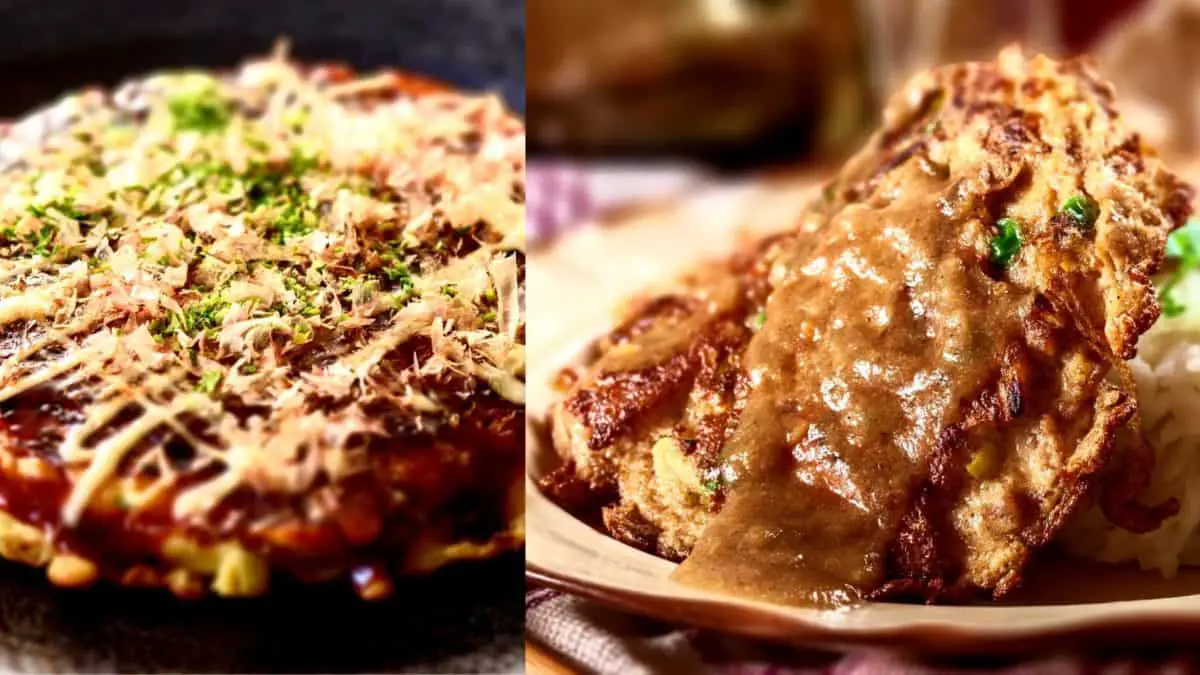Okonomiyaki vs egg foo young: How to tell them apart
If you’re looking for a delicious new meal to try, you can’t go wrong with okonomiyaki or egg foo young.
These two dishes are often compared to one another, and though they share some similarities, there are also some stark differences between the two.
Let’s take a closer look at each dish and see which one comes out on top!


Check out our new cookbook
Bitemybun's family recipes with complete meal planner and recipe guide.
Try it out for free with Kindle Unlimited:
Read for freeIn this post we'll cover:
What is okonomiyaki?
Okonomiyaki is a Japanese dish that can be best described as a savory pancake. It’s made with a batter of eggs, flour, and water, and typically includes cabbage, meat, and seafood. Once it’s cooked, it’s topped with a variety of sauces and toppings, such as mayonnaise, ketchup, and pickled ginger.
What is egg foo young?
Egg foo young is a Chinese dish that’s similar to an omelet. It’s made with eggs, vegetables, and meat, and is often served with rice. Once it’s cooked, it’s usually topped with a sauce, such as soy sauce or hoisin sauce.
Similarities & differences
Okonomiyaki and egg foo young may be different dishes from different cultures, but there are some similarities between them. Both are made with eggs and can be served with a variety of sauces and toppings.
The sauce for egg foo young is more like a gravy than a sauce, and that’s probably why it’s eaten on a bed of rice. Okonomiyaki sauce is way sweeter and it usually has mayo on it as well.
Egg foo young is more of a crispy fried omelet than a pancake, which is probably another reason it’s not eaten on its own.
There are also some more differences between the two dishes. Okonomiyaki is made with a batter, while egg foo young is not. Additionally, okonomiyaki typically includes cabbage, while egg foo young does not. And finally, egg foo young is usually served with rice, while okonomiyaki is not.
History of okonomiyaki and egg foo young
Okonomiyaki is thought to have originated in Osaka, Japan during the Edo period. It’s said that the dish was created as a way to use up leftovers. Egg foo young, on the other hand, is thought to have originated in Guangzhou, China. It’s said that the dish was created as a way to make use of eggs that were left over from making egg rolls.
A lot of similarities there!
Comparison of the ingredients used in each dish
Okonomiyaki:
-Eggs
-Flour
-Water
-Cabbage
-Meat (usually pork)
-Seafood (usually shrimp)
-Sauces (such as mayonnaise, ketchup, and pickled ginger)
-Toppings (such as green onions, bonito flakes, and nori)
Egg Foo Young:
-Eggs
-Vegetables (usually onion, green onion, mushrooms, and bean sprouts)
-Meat (usually pork, chicken, or shrimp)
-Sauce (such as soy sauce or hoisin sauce)
-Rice
How each dish is cooked
Okonomiyaki is typically cooked on a griddle or frying pan, while egg foo young is usually deep-fried. This means that okonomiyaki will have a crispy crust on the bottom with a softer top and interior, while egg foo young will be more crispy and fluffy.
How the flavors differ
Okonomiyaki is a savory dish with a slightly sweet sauce, while egg foo young is more savory with a salty sauce. The cabbage in okonomiyaki also gives it a slightly crunchy texture, while the vegetables in egg foo young make it more soft and delicate.
Conclusion
So, there you have it! A comparison of two delicious dishes that are often mistaken for one another. Though they may share some similarities, there are also some key differences between the two.
So, next time you’re in the mood for a savory pancake or a crispy fried omelet, you’ll know exactly which dish to order!
Also read: these are the best ways to make okonomiyaki sauce
Check out our new cookbook
Bitemybun's family recipes with complete meal planner and recipe guide.
Try it out for free with Kindle Unlimited:
Read for freeJoost Nusselder, the founder of Bite My Bun is a content marketer, dad and loves trying out new food with Japanese food at the heart of his passion, and together with his team he's been creating in-depth blog articles since 2016 to help loyal readers with recipes and cooking tips.
